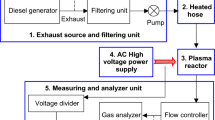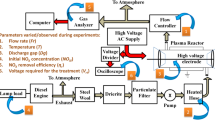Abstract
Diesel exhaust treatment in plasma environment is a complex phenomenon mainly involving oxidation of several gaseous pollutants. With the help of artificial neural network, an attempt has been made in this paper to predict the variation of nitric oxide/nitrogen dioxide when the exhaust is subjected to discharge plasma. Electrical (power and frequency) and physical (engine load and flow rate) parameters have been considered as inputs of a three-layered artificial neural network model to track the performance of the treatment. Two different backpropagation algorithms named Bayesian regularization and Levenberg–Marquardt have been applied to compare the prediction performance. Bayesian regularization training algorithm shows better agreement with the experimental data than Levenberg–Marquardt in terms of root-mean-square error and correlation coefficient. Further, sensitivity analysis has been carried out to obtain an insight about the relative importance of input parameters on output parameters. This investigation shows that the applied input power is the most influential among the four input parameters from the point of variation of nitric oxide/nitrogen dioxide.






Similar content being viewed by others
References
Alsmadi MKS, Omar KB, Noah SA et al (2009) Back propagation algorithm: the best algorithm among the multi-layer perceptron algorithm. Int J Comput Sci Netw Secur 9:378–383
Apeksha M, Rajanikanth BS (2018) Plasma/adsorbent system for NOx treatment in diesel exhaust: a case study on solid industrial wastes. Int J Environ Sci Technol. https://doi.org/10.1007/s13762-018-1776-x
Balestrassi PP, Popova E, Paiva APd, Lima JWM (2009) Design of experiments on neural network’s training for nonlinear time series forecasting. Neurocomputing 72:1160–1178
Bui DT et al (2012) Landslide susceptibility assessment in the Hoa Binh province of Vietnam: a comparison of the Levenberg–Marquardt and Bayesian regularized neural networks. Geomorphology 171:12–29
Chakraborty D, Pal NR (2003) A novel training scheme for multilayered perceptrons to realize proper generalization and incremental learning. IEEE Trans Neural Netw 14:1–14
Demuth H, Beale M (2000) Neural network toolbox user’s guide
Eskander GS, et al. (2007) Round trip time prediction using the symbolic function network approach. Information Technology Convergence. In: International symposium on IEEE, pp 3–7
Foresee FD, Hagan MT (1997) Gauss–Newton approximation to Bayesian learning. In: Proceedings of the 1997 international joint conference on neutral networks, vol 3, pp 1930–1935
Gadkari S, Gu S (2017) Numerical investigation of co-axial DBD: influence of relative permittivity of the dielectric barrier, applied voltage amplitude, and frequency. Phys Plasmas 24:053517
Garson GD (1991) Interpreting neural-network connection weights. AI Expert 6:46–51
Hagan MT, Menhaj MB (1994) Training feedforward networks with the Marquardt algorithm. IEEE Trans Neural Netw 5:989–993
Hagan MT, Demuth HB, Beale MH, De Jesús O (1996) Neural network design, vol 20. PWS Pub, Boston
Ibrahim OM (2013) A comparison of methods for assessing the relative importance of input variables in artificial neural networks. J Appl Sci Res 9:5692–5700
Istadi I, Amin NAS (2007) Modelling and optimization of catalytic–dielectric barrier discharge plasma reactor for methane and carbon dioxide conversion using hybrid artificial neural network—genetic algorithm technique. Chem Eng Sci 62:6568–6581
Kayri M (2016) Predictive abilities of bayesian regularization and Levenberg–Marquardt algorithms in artificial neural networks: a comparative empirical study on social data. Math Comput Appl 21:20
Liu SY, Mei DH, Shen Z, Tu X (2014) Nonoxidative conversion of methane in a dielectric barrier discharge reactor: prediction of reaction performance based on neural network model. J Phys Chem C 118:10686–10693
Lourakis MIA (2005) A brief description of the Levenberg–Marquardt algorithm implemented by levmar. Found Res Technol 4:1–6
Mohammadhassani J, Khalilarya S, Solimanpur M, Dadvand A (2012) Prediction of NOx emissions from a direct injection diesel engine using artificial neural network. Model Simul Eng 2012:12
Montgomery DC (2017) Design and analysis of experiments. Wiley, Hoboken
Ning Y, Liu Y, Zhang H, Ji Q (2010) Comparison of different BP neural network models for short-term load forecasting. In: IEEE international conference intelligent computing and intelligent systems (ICIS) 2010, vol 3, pp 435–438
Oguz E, Tortum A, Keskinler B (2008) Determination of the apparent rate constants of the degradation of humic substances by ozonation and modeling of the removal of humic substances from the aqueous solutions with neural network. J Hazard Mater 157:455–463
Okut H et al (2013) Predicting expected progeny difference for marbling score in Angus cattle using artificial neural networks and Bayesian regression models. Genet Sel Evol 45:34
Olden JD, Jackson DA (2002) Illuminating the “black box”: a randomization approach for understanding variable contributions in artificial neural networks. Ecol Model 154:135–150
Olden JD, Joy MK, Death RG (2004) An accurate comparison of methods for quantifying variable importance in artificial neural networks using simulated data. Ecol Model 178:389–397
Patel JL, Goyal RK (2007) Applications of artificial neural networks in medical science. Curr Clin Pharmacol 2:217–226
Rahmanian B, Pakizeh M, Mansoori SAA, Abedini R (2011) Application of experimental design approach and artificial neural network (ANN) for the determination of potential micellar-enhanced ultrafiltration process. J Hazard Mater 187:67–74
Srinivasan AD, Rajanikanth BS, Mahapatro S (2009) Corona treatment for NOx reduction from stationary diesel engine exhaust impact of nature of energization and exhaust composition. In: Proceedings electrostatics joint conference, pp 1–7
Talebizadeh P et al (2014) The role of non-thermal plasma technique in NOx treatment: a review. Renew Sustain Energy Rev 40:886–901
Toma F-L et al (2004) Neural computation to predict TiO2 photocatalytic efficiency for nitrogen oxides removal. J Photochem Photobiol A Chem 165:91–96
Yamamoto T, Okubo M, Hayakawa K, Kitaura K (1999) Towards ideal NOx/control technology using plasma-chemical hybrid process. In: Industry applications conference. 34th IAS annual meeting, 1999. Conference record of the 1999 IEEE, vol 3, pp 1495–1502
Acknowledgements
This work is part of in-house research and not supported by any external funding agency.
Author information
Authors and Affiliations
Corresponding author
Ethics declarations
Conflict of interest
The authors declare that there is no conflict of interest whatsoever with anyone related directly/indirectly with this work.
Additional information
Editorial responsibility: Iskender AKKURT.
Rights and permissions
About this article
Cite this article
Mukherjee, D.S., Rajanikanth, B.S. Prediction of variation of oxides of nitrogen in plasma-based diesel exhaust treatment using artificial neural network. Int. J. Environ. Sci. Technol. 16, 6315–6328 (2019). https://doi.org/10.1007/s13762-019-02242-5
Received:
Revised:
Accepted:
Published:
Issue Date:
DOI: https://doi.org/10.1007/s13762-019-02242-5




